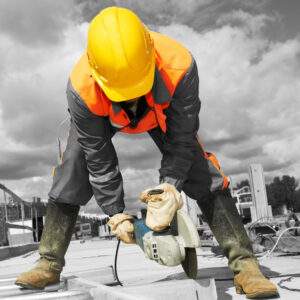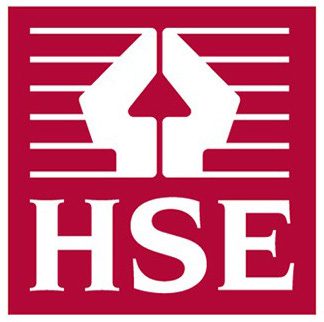In the HSEs latest project, they have been looking at alternative processes to grinding due to the ill-health effects caused by the vibration exposure of such activities.
The project shows that real-use vibration magnitude measurements on angle grinders consistently give values between 7 to 9 m/s². Vibration levels in this range increase the risk of ill health to operators regularly using these machines for as little as 20 minutes per day. This concurs with the high number of hand-arm vibration syndrome (HAVS) incidents that have been reported to RIDDOR from steel frame fabrication activity recently.
The HSE are very clear in their advice to organisation who regularly use grinders as part of their work:
The most effective way of controlling exposures from grinders
is to reduce or eliminate the use of these machines.
The team behind HAVSPRO 100% agree that every effort should be made to reduce or eliminate the risk of vibration exposure, especially when using such high-risk tools such as grinders. But what are the alternatives and how can they be implemented?
 This HSE project investigated alternative processes to grinding as well as methods designed to reduce vibration exposure for users when grinding. They tested a range of different consumables for the grinders as well as alternative tools.
This HSE project investigated alternative processes to grinding as well as methods designed to reduce vibration exposure for users when grinding. They tested a range of different consumables for the grinders as well as alternative tools.
A part of the project, the HSE tested the vibration levels of different abrasive wheels such as: standard grinding wheels, flap discs, ceramic discs, fibre disc with a rubber backing pad, diamond discs and carbon discs, with each wheel being subject to three different tasks: grinding, bevelling and cutting.
The HSE then tested alternative tools such as rebar cutters, bevelling machines and an angle grinder with a built in autobalancer, all of which were measured for vibration levels when subject to the same three tasks: grinding, bevelling and cutting.
For a full breakdown of the project, visit the HSE website.
The Solution for vibration exposure when grinding
When grinding, bevelling and cutting, the tests showed that there are alternatives that could reduce the worker’s vibration exposure when compared to standard wheels and angle grinders. It is therefore, essential that looking for alternative machines, processes and consumables should all be considered as part of your vibration risk assessment for grinding tasks.
In addition, the HSE state that there are machines available on the market that produce higher levels of vibration, but significantly reduce the time it takes to complete the task and therefore reduce a worker’s overall vibration exposure. For example, although the bevelling machine tested produced nearly twice the vibration level, it completed the task in a tenth of the time.
It is therefore, essential that when you are looking to reduce a workers vibration exposure to as low as reasonably practicable (ALARP), you understand the exact risk of vibration exposure and how you can manage it. Continuous measuring and monitoring of vibration levels are deemed to be unnecessary by the HSE but how do you know, with any certainty or accuracy, that you have the lowest vibration exposure levels for your business and your operatives?
 For the grinding task it was found that the fibre disc and rubber backing pad produced the lowest vibration and completed the task in the quickest time. When the standard angle grinder was used with anti-vibration handles, it was shown to consistently reduce vibration regardless of the wheel used.
For the grinding task it was found that the fibre disc and rubber backing pad produced the lowest vibration and completed the task in the quickest time. When the standard angle grinder was used with anti-vibration handles, it was shown to consistently reduce vibration regardless of the wheel used.
Again, whilst this is a great insight, and can go a long way to informing your vibration risk management strategies, it doesn’t offer any certainty that your operatives are being protected every time they pick up an angle grinder – only continuous measuring and monitoring will give you this level of certainty.
The project also showed that the three bevelling machines produced lower vibration levels and were more efficient than a standard angle grinder. For cutting using an angle grinder, the lowest vibration levels were produced using a diamond disc. However, this disc was inefficient at completing the task and, in some cases, did not cut the whole way through the rebar in the measurement period.
This further highlights the need for continuous measuring and monitoring of vibration levels in your specific environment, with your own operatives, to ensure you are acting on accurate, real-time data and not test data.
The Outcome
This HSE project demonstrates that there are alternative machines and consumables available that can reduce vibration levels when compared to standard angle grinders and discs. However, according to the HSE; “it is important that dutyholders take a holistic view and look at the overall reductions that can be made. Alternatives to angle grinders should be considered where possible.”
When engaging in any tasks that involve the use of angle grinders, the HSE guidance is to identify efficient machines for the job, avoiding any high vibration models, and then manage the remaining vibration risk.
The HAVSPRO team also strongly recommend this and urge all organisations and operatives who use angle grinders, in any form, to regularly review the task, the tool used and the wheel used, to see if an alternative could be more suitable.
But, if no alternative can be found, and you’re looking for a system that can;
- automate measuring and monitoring of vibration exposure,
- provide you with accurate, real-time vibration data (in HSE points),
- show you which tools and operators are experiencing high vibration levels and proactively alert you to the fact,
- help identify problems as they occur,
- show you every time a tool is used, and
- even help identify training needs,
then give the HAVSPRO team a call on 01332 547 148 or download the brochure now.
Download the HAVSPRO Brochure
Discover how HAVSPRO monitors vibration levels accurately and triggers alerts to protect your staff and organisation against the risks of HAVS and WBV (whole body vibration).
It monitors individual tool vibration levels and the exposure each person has to it.
HAVSPRO then collates all this data and creates customisable reports to help you prevent overexposure.
Find out everything you need to know in our brochure – simply complete the form!
Find out more about HAVSPRO and how it can help you protect your staff and business: 01332 547 148 or you can download our Employers Guide to HAVS


